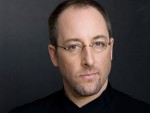Title
Body
Programming works by Gérard Grisey, Harrison Birtwistle, and Magnus Lindberg might seem arbitrary, but Jeffrey Milarsky, who has done just that for the opening concert of the Axiom ensemble’s seventh season, e-mailed The Journal that he hopes this combination will allow “audiences and performers alike to find connections, contradictions, and beauty in these three seemingly disparate works.” Milarsky, the music director and conductor of the group, will lead the concert, which takes place on October 13.
At the crux of the program is Grisey’s 1994-96 Vortex Temporum (“Whirlwind of Time”). Along with Tristan Murail, Grisey (1946-1998) is known as a father of spectralism. He was a student of both Olivier Messiaen and Henri Dutilleux and inherited from each of them a sensitivity to harmony, orchestration, and aural color. With a distinctive musical voice and a deeply felt enthusiasm for acoustic research, Grisey’s “spectral explorations are not merely exercises but organic structures, as structurally sound as Bach or Bartok,” Milarsky said. Vortex Temporum, scored for piano, clarinet, flute, violin, viola, and cello, was one of Grisey’s final works, and though it’s less dense and harmonically simpler than some of his earlier compositions, it still uses many layers of sound and employs microtones. For Milarsky, Grisey’s music has been important. “It has taught me much about phrasing, pacing, intensity, and color. I am confident that the Juilliard folks will find a masterpiece in Vortex Temporum.”
Fourth-year cellist Jay Campbell, who will be one of the performers, had a more visceral reaction to the piece when he first heard it. “It’s really a brain-melting experience to hear it, especially live,” he told The Journal by e-mail. “It’s really kind of psychedelic, not even just sonically, but also in [Grisey’s] exploration of one’s temporal perception. It’s pretty hard to listen to it and walk away not feeling a little funny upstairs—but in a good way, sort of like some of the stranger Messiaen pieces, like Et exspecto [resurrectionem mortuorem (1964)] or Chronochromie [1958-60], maybe.”
Harrison Birtwistle’s Silbury Air (1977) will follow Vortex. Milarsky called Birtwistle, who was born in 1934, “a puzzling creative genius.” Often, his works are theatrical and dramatic, and many focus on a single element in music. Milarsky explained, “Silbury Air is based upon a rhythmic matrix. We sometimes forget that this element of music can be passionate, intense, emotive, and essential. This elemental piece has such a distinctive sound world. Birtwistle uses his own bizarre voice leading, fractured phrases, and dynamic thrust to achieve maximum intensity.” Silbury Air was written for a 15-instrument sinfonietta, the ensemble on which Axiom was originally based. Its namesake is a prehistoric hill in Wiltshire, England, which the composer has described as “an artificial but organic intruder of the landscape.”
The final work on the program will be Action-Situation-Signification (1982) by Magnus Lindberg, who was born in 1958. Lindberg, who is the composer-in-residence of the New York Philharmonic, was a student of Grisey’s and is also a personal friend of Milarsky’s. Over the past four years, Axiom has performed several of his works, including Corrente(1992), Engine (1996), UR (1986), and Joy (1989). Milarsky called Lindberg “one of the most evenly balanced composers alive today. His music has gone through incredible transformations over the course of his career. It is very exciting to have him in New York, and I have taken every opportunity to program almost every style of his music.”
Action-Situation-Signification was written for Toimii, the experimental new-music ensemble founded by Lindberg and conductor Esa-Pekka Salonen. Along with Kraft (1983-95), Action-Situation-Signification is often credited for Lindberg’s breakthrough and early success. The work is a study in instrumental musique concrète, a form of electroacoustic music that uses acousmatic sound, or sound that an audience hears without seeing its source. In Action-Situation-Signification, Lindberg pairs the live playing of the ensemble with taped recordings of sounds from nature: sea, rain, fire, wind, earth, wood, and metal. Milarsky mentioned that it has been called Lindberg’s “most experimental and eccentric piece.”
Later this season, Axiom will perform works by Milton Babbitt, Elliot Carter, and Pierre Boulez (in December) and Wolfgang Rihm (in February). Milarsky’s goal for this season is the same as it has been in previous ones: to program music that deserves ample rehearsal time and detailed performances in order “to serve the increasingly virtuosic players at Juilliard, while exploring masterpieces of the genre.” And while he hopes to excite listeners through the performers’ “passion of delivery,” Axiom also must “present a cohesive package and groups of works that reflect upon one another, that sometimes contrast, that sometimes influence, and that sometimes complement one another.”





